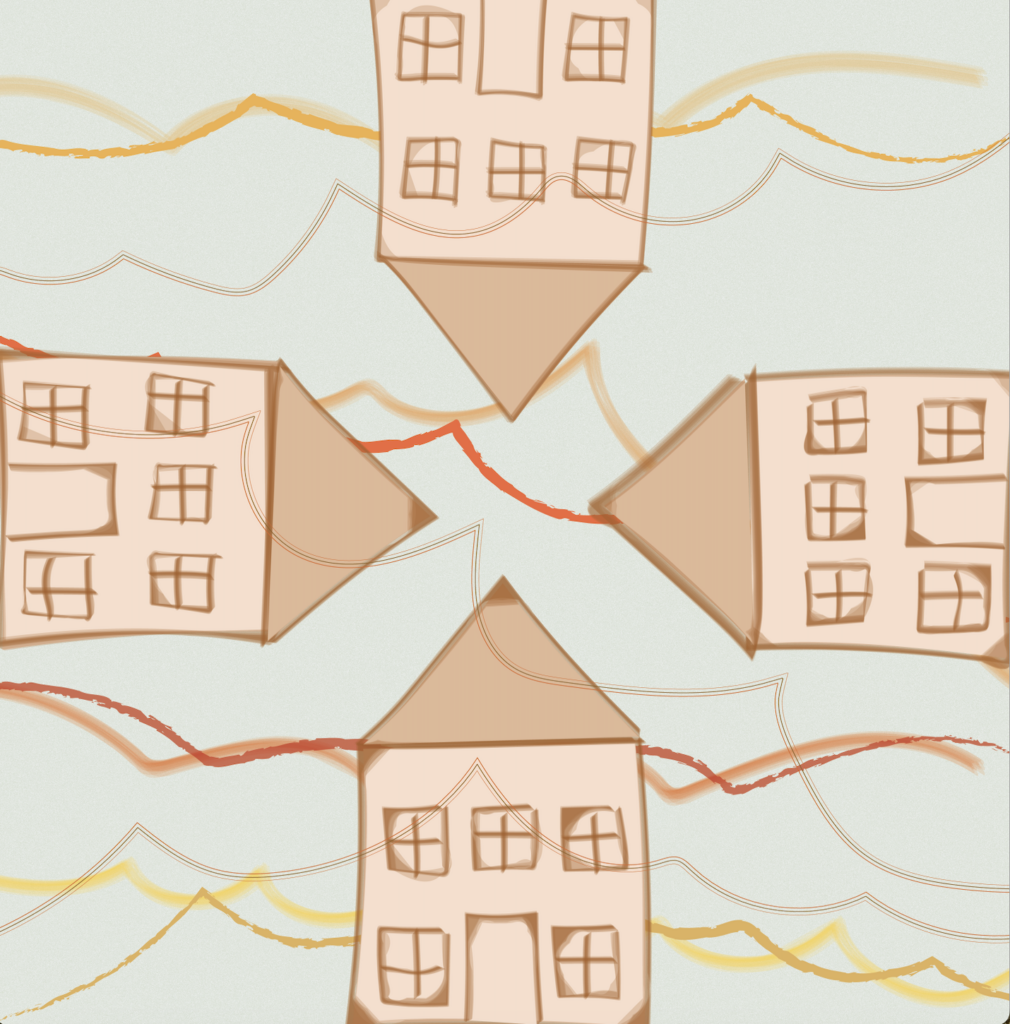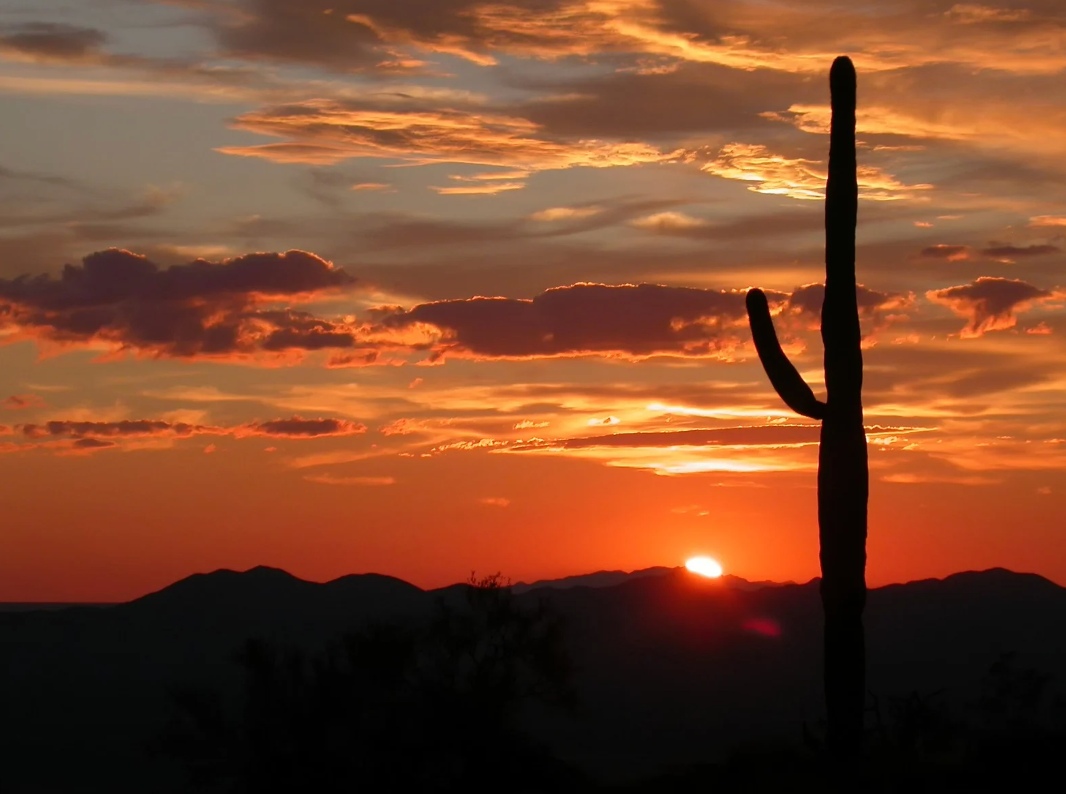A Climate Autobiography: Reflecting on Cultural Adaptation in the Sonoran Sun
By Aayush Murarka, SFS ’26

Illustration of four beige houses with orange and yellow waves against a dusty blue background. Design by Cecilia Cassidy.
“140°F.” A text message with a picture of my mom’s car thermometer. It took me a moment to figure out what I was looking at in that picture of the gauge cluster; maybe her aging Mercedes had reached some odometer milestone, or the engine had finally given out after periods of desperate sputtering. Actually, it was the cabin temperature that she had wanted me to see.
“140°F.” Her car was at pasteurization temperatures after sitting in the parking lot of her office building.
Taming Arizona
There is an eerie irony in seeing her car get that deathly warm. Phoenix, Arizona is a city of hubris, a sprawl of manicured lawns and golf courses, fierce libertarianism, and car-dependent infrastructure as far as the eye can see. The withering heat, of course, necessitates the latter. Parking lots, in particular, spill all over the Phoenix Metro Area and its suburbs. In those parking lots, the cars we use to escape the heat bake in the Sonoran sun and torment passengers until the A/C kicks in. Wriggle and squirm in the burning seats as much as you like, invest in remote-start engines and buy windshield reflectors — there is simply no escaping the heat.
If you listen to the “snowbirds,” the retirees escaping frigid weather by flocking to the Phoenix Metro Area, you would be convinced that Arizona’s environment is rather tame — after all, we are free of the earthquakes of the West Coast, hurricanes of the East Coast and tornadoes and blizzards of the Midwest. Look a little closer, and you’ll encounter imposing walls of dust sweeping the valley or flocks of dark clouds descending to flood the landscape. But none of these hold a candle to the devastating specter that haunts my state: the heat wave. Invisible and deadly, devastating and invasive, a heat wave laid waste to my hometown this summer.
The Heat Wave
Though you might hear a Phoenix resident brush off the temperature spike as just another scorching summer, this heat wave was an extreme climate event. The National Oceanic and Atmospheric Administration defines an extreme event as “a time and place in which weather, climate, or environmental conditions — such as temperature, precipitation, drought, or flooding — rank above a threshold value near the upper or lower ends of the range of historical measurements.” This heat wave was definitively extreme; the 31-day streak of temperatures at or above 110 degrees almost doubled the previous record of 18 days. The desert nights held significantly less mercy this summer, as the temperature did not drop below 90 degrees for 16 straight days. Even Northern cities such as Flagstaff, Arizona, where my parents took me to play in the snow as a kid, stayed above 90 degrees for 10 days straight, the second-longest streak in history. To hold the record for the hottest month in one of the hottest cities is no small feat. Although it is part of a larger climate trend, it is an acute climate event nonetheless.
Unfortunately, when your state breaks a new record almost every year, it is hard to treat “one bad summer” as a climate event. Naomi Klein, in her book “This Changes Everything,” talks about this form of climate denial and exhaustion, calling it the tendency to “look for a split second” before one closes their eyes and moves on. After all, who wants to think about our role in the slow demise of the planet?
Even for those who believe in climate change, guilt, helplessness and apathy cripple our capacity for serious reflection and conversation.
Coming to D.C. and talking with East Coast natives convinced me further of shortening climate attention spans. I could scarcely complain about Georgetown’s summer heat without the endless refrain of “Isn’t Arizona supposed to be hotter?” and “You’re from Arizona, right?” The most common rebuttal was some form of “Oh, but you must be used to the heat, so this is no big deal.” Can anyone really “get used to” a month of 110+ degree weather?
Lessons from India
In all fairness, I asked my parents similar questions these last couple months. Hailing from India, they are no strangers to the kind of heat that fills your lungs and drowns you on dry land. My summer trips to India were filled with sweat, heat sickness, and tower-toppling monsoon floods. The longest I lasted was about a month and a half before I began to miss Arizona summers. My mom went 25 years before leaving India for the first time, so who better to ask than her about how to cope with the heat?
My mom grew up in extreme summer conditions in Uttar Pradesh. Swamp coolers filled in for A/Cs, where a water-soaked screen was placed in front of a fan for a cooling effect. When the electricity failed at night, my mom and the cousins would sleep on the terrace, hoping that the tiles could wick away some of the heat of the midday sun. With decent water pressure on a good day, a cold shower relieved them of the daily stuffiness. There was no place for leftovers, as even refrigeration could not keep food from spoiling in the heat. As for the food itself, the menu changed to include hydrating and cooling ingredients, like watermelon and mint. If the yogurt went sour, then they would eat khadi, which is made from the soured yogurt and gram flour. Beyond day-to-day survival, my mom’s summers always included a trip to her grandmother’s house. In the atrium of the rural bungalow, the floor would be filled with mangos and flooded with water to keep them cool. It was how her culture adapted to the environment that sustained it. However, I have watched these practices atrophy as we settled into a life in suburban Arizona.
From the Frying Pan into the Fire
Like many college-educated Indian adults of their time, my parents got married and immigrated to the United States, ultimately settling in Arizona. Arizona’s dry weather is ideal for semiconductor and electronics manufacturing, industries that drew many Indian electrical engineers to the Pheonix Metro Area. As a result, my suburban high school is around 80% Asian.
Cultural adaptation seems to evaporate when those cultures are put in a context antithetical to it. This summer stood out to me because I could see a warped reflection of my childhood summers during the two months I spent with my 9-year-old brother. The heat kept us both inside; he could not bike to a friend’s house, garden outside with my mom and tend to the withering plants, or play soccer, all of which I could do ten years ago. More than any other year, the heat proved to me that we went from getting used to our environment to making our environment used to us. We trap ourselves indoors with the A/C which inadvertently warms our surroundings and creates urban heat islands. This almost inevitably causes the A/C to overheat–a misfortune we suffered twice this summer. Thus, in an attempt to keep ourselves cold, we worsen the heat from which we seek reprieve.
This summer, a day did not go by without a conversation about how hot it was getting. The heat was defining: a spray-painting job for a home project kept me in the midday sun for 20 minutes, and I blacked out the second I stepped inside. But it was always blamed on Arizona, and never anything outside of that. It was not scary because it was hot, it was just inconvenient. Just like we flee the sun’s stifling rays under shady trees and temperature-controlled homes, we Arizonans have fled from open and honest conversations about changing our ways of thinking and living with the desert.
Climate change is usually understood within the context of industrial and universal blame, but the residents of Arizona engage in environmental blame, in which the region itself is responsible for its own destruction. People say, “if we are not supposed to use A/C, Arizona should not be so hot!”
What’s Next?
The future seems as hazy as asphalt mirages. California residents, fleeing higher prices (and soon, higher tides), have flooded into Arizona. Amitav Ghosh writes about this phenomenon as a form of “reverse temporality.” Throughout history, Western modernity’s goals of mercantile globalization have manifested in coastal metropolitan areas and cities, which will ironically be the first to be destroyed by rising sea levels. The traditions that kept my parents cool will be washed away in India’s torrential rains or evaporated away in the industrial comforts of suburban life, in which whiteness, nuclear families, and 9-5 capitalism suffocate any alternative methods of living. I know that, without change, I will be escaping the land of opportunity that my parents migrated to. Rather than imagine course corrections and structural changes in response to a growing threat, we entrench ourselves in the banal trudge against a “bothersome inconvenience.” Case in point, at my office that summer we chatted about not being able to golf as often in the summer heat, rather than question the irrigated oasis in the drought. I am guilty of this too; it is hard to casually bring up climate change without being called a bummer, or worse.
Three years ago, I worked on the campaign to elect Mark Kelly (D-AZ) to the Senate, hopeful that his past as an astronaut would allow science and climate data to inform national policymaking. On July 16th, in the throes of the heat wave, the man for whom I spent days campaigning said “We need to do more,” while protecting moderates like Joe Manchin, who called climate legislation a “radical agenda”. This summer taught me that it was not up to me, and that my fate was not in my own hands. I would be better off taking my chances with the sun than the politicians who I thought would protect me and my brother.
Beyond Borders
This dissolution of accountability is a symptom of a larger national and global disease. The Global North expects the Global South to cope with the consequences of colonial industrialism. When countries like India are confronted with climate realities, they retort that the fossil fuel model of development launched the economic futures of the West, and they have the right to do what is best for their citizens. With fossil fuel development comes the cultural imperialism that I have seen wipe out practices within my own household, depriving us of sustainable models of adapting to our environment. Fossil fuel development has created corruption and misinformation through underhanded lobbying and corrupt think tanks; the famously pro-fossil fuel Cato Institute touted the deregulatory efforts of former Arizona Governor Doug Ducey, who only recently admitted that climate change may be linked to human activity. Indigenous communities have long inhabited Arizona prior to the 2-story single-family home, and they created sustainable communities on cliffsides. Is “human activity” really responsible?
It’s truly a mind-boggling exercise to wrap your mind around the scale of the problem, because you are forced to multiply your own experiences and use your imagination to fill in the gaps. Species are going extinct and my slippers are melting on the roads. Whole swaths of my mother country are flooding and my brother was stuck indoors all summer. Layers of privilege filter our own experiences with climate change, as one’s cultural adaptations slowly atrophy. Whether you bury yourself in the desert sand, protest outside the State Capitol while desperately trying to avoid heatstroke, or merely try to go about your suburban summer, the last 14 years of my life have taught me that this heat will not hesitate to vaporize us all.

